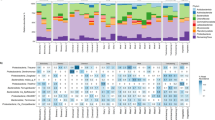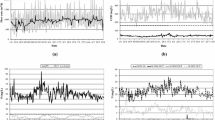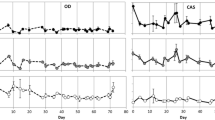Abstract
A survey in 16 activated sludge wastewater treatment plants (WWTP) was conducted to contribute to the knowledge of the environmental parameters that determine the composition of the filamentous community. A total of 128 samples of mixed liquor from municipal WWTP were collected during 2 years, and 22 filamentous morphotypes were identified. The most frequent and abundant filamentous bacteria were, in both cases and by this order, type 0041/0675, type 0092, Microthrix parvicella and 1851, nocardioforms and Haliscomenobacter hydrossis. Concerning dominance, type 1851 was the most frequently dominant morphotype, followed by M. parvicella and types 0092 and 0041/0675. These were also, and by this order, the dominant morphotypes during bulking occurrences. Significant correlations were obtained between the abundance of filamentous bacteria and environmental parameters, but multivariate statistical analysis only confirmed the correlation between type 0092 and Sludge Volume Index (SVI), emphasizing the association of this filament with bulking. The discussion of the results in light of published works was complicated by the random use of terms such as frequency, abundance, and dominance with different and often unclear meanings. This reinforces the need of clarifying these terms when discussing the causes of filamentous overgrowth in WWTP.



Similar content being viewed by others
References
Amann RI, Krumholz L, Stahl DA (1990) Fluorescent-oligonucleotide probing of whole cells for determinative, phylogenetic, and environmental studies in microbiology. J Bacteriol 172:762–770
APHA/AWWA/WEF (1995) Standard methods for the evaluation of water and wastewater, 19th edn. APHA, Washington
Beer M, Seviour EM, Kong Y, Cunningham M, Blackall LL, Seviour RJ (2002) Phylogeny of the filamentous bacterium Eikelboom type 1851, and design and application of a 16S rRNA targeted oligonucleotide probe for its fluorescence in situ identification in activated sludge. FEMS Microbiol Lett 207:179–183
Bjornsson L, Hugenholtz P, Tyson GW, Blackall LL (2002) Filamentous Chloroflexi (green non-sulfur bacteria) are abundant in wastewater treatment processes with biological nutrient removal. Microbiology 148:2309–2318
Blackbeard JR, Ekama GA, Marais GVR (1986) A survey of bulking and foaming activated sludge plants in South Africa. J Water Pollut Control Fed 85:90–100
Blackbeard JR, Gabb D, Ekama GA, Marais GR (1988) A survey of filamentous bulking and foaming in activated sludge plants in South Africa. Water SA 14:29–33
Bux F, Kasan HC (1994) A microbiological survey of ten activated sludge plants. Water SA 20:61–71
Daims H, Bruhl A, Amann R, Schleifer KH, Wagner M (1999) The domain-specific probe EUB338 is insufficient for the detection of all bacteria: development and evaluation of a more comprehensive probe set. Syst Appl Microbiol 22:434–444
Davenport RJ, Curtis TP, Goodfellow M, Stainsby FM, Bingley M (2000) Quantitative use of fluorescent in situ hybridization to examine relationships between mycolic acid-containing actinomycetes and foaming in activated sludge plants. Appl Environ Microbiol 66:1158–1166
Eikelboom DH (1975) Filamentous organisms observed in activated sludge. Water Res 9:365–388
Eikelboom DH (2000) Process control of activated sludge plants by microscopic investigation. IWA Publishing, London, UK
Eikelboom DH, Andreadakis A, Andreasen K (1998) Survey of filamentous populationsin nutrient removal plants in four European countries. Water Sci Technol 37:281–289
Erhart R, Bradford D, Seviour RJ, Amann R, Blackall LL (1997) Development and use of fluorescent in situ hybridization probes for the detection and identification of Microthrix parvicella in activated sludge. Syst Appl Microbiol 20:310–318
Gich F, Garcia-Gil J, Overmann J (2001) Previously unknown and phylogenetically diverse members of the green nonsulfur bacteria are indigenous to freshwater lakes. Arch Microbiol 177:1–10
Hair JF, Anderson RE, Tatham RL, Black WC (1995) Multivariate data analysis. Prentice Hall, Englewood Cliffs, NJ
Jenkins D, Richard MG, Daigger GT (1993) Manual on the causes and control of activated sludge bulking and foaming, 2nd edn. Lewis Publishers, Michigan, USA
Jenkins D, Richard MG, Daigger GT (2004) Manual on the causes and control of activated sludge bulking, foaming, and other solids separation problems, 3rd edn. Lewis Publisher, NY, USA
Kanagawa T, Kamagata Y, Shinobu A, Tetsuro K, Horn M, Wagner M (2000) Phylogenetic analysis and oligonucleotide probe development for the eikelboom type 021N filamentous bacteria isolated from bulking activated sludge. Appl Environ Microbiol 66:5043–5052
Kragelund C, Levantesi C, Borger A, Thelen K, Eikelboom D, Tandoi V, Kong Y, Krooneman J, Larsen P, Thomsen TR, Nielsen PH (2008) Identity, abundance and ecophysiology of filamentous bacteria belonging to the bacteroidetes present in activated sludge plants. Microbiol 154:886–894
Lacko N, Bux F, Kasan HC (1999) Survey of filamentous bacteria in activated sludge plants in KwaZulu-Natal. Water SA 25:63–68
Madoni P, Davoli D, Gibin G (2000) Survey of filamentous microorganisms from bulking and foaming activated-sludge plants in Italy. Water Res 34:1767–1772
Madoni P, Davoli C, Davoli D, Guglielmi L, Pergetti M, Stefanini C (2005) Depurazione biologica nei fanghi attivi. Universita degli Studi di Parma; Enia S.p.A. – Sede di Reggio Emilia, Italia
Martins A, Pagilla K, Heijnen J, van Loosdrecht M (2004) Filamentous bulking sludge: a critical review. Water Res 38:793–817
Müller E, Schade M, Lemmer H (2007) Filamentous scum bacteria in activated sludge plants: detection and identification quality by conventional activated sludge microscopy versus fluorescence in situ hybridization. Water Environ Res 79:2274–2286
Nielsen PH, Daims H, Lemmer H (2009) FISH handbook for biological wastewater treatment. IWA Publishing, London, UK
Rampersad K (2002) Survey of filamentous bacteria in activated sludge plants and the effect of seasonal variations. Biennial Conference of the Water Institute of Southern Africa (WISA) 19 - 23 May, Durban
Seviour RJ, Blackall LL (1999) The microbiology of activated sludge. Kluwer Academic Publishers, Dordrecht, Netherlands
Seviour R, Nielsen PH (2010) Microbial ecology of activated sludge. IWA Publishing, London, UK
Speirs L, Nittami T, McIlroy S, Schroeder S, Seviour RJ (2009) Filamentous bacterium Eikelboom type 0092 in activated sludge plants in Australia is a member of the phylum Chloroflexi. Appl Environ Microbiol 75:2446–2452
Spigoni G, Davoli C, Davoli D (1992) I principali microrganismi filamentosi del fango attivo: caratteristiche ecologiche e metodi di identificazione. Quaderni tecnici dell’AGAC, n5
Tandoi V, Jenkins D, Wanner J (2006) Activated sludge separation problems. IWA Publishing, London, UK
Wagner M, Erhart R, Manz W, Amann RI, Lemmer H, Wedi D, Schleifer KH (1994) Development of an R-RNA-targeted oligonucleotide probe specific for the genus acinetobacter and its application for in situ monitoring in activated sludge. Appl Environ Microbiol 60:792–800
Wallner G, Amann R, Beisker W (1993) Optimizing fluorescent in situ hybridization with rRNA-targeted oligonucleotide probes for flow cytometric identification of microorganisms. Cytometry 14:136–143
Wanner J, Grau P (1989) Identification of filamentous microorganisms from activated sludge: a compromise between wishes, needs and possibilities. Water Res 23:883–891
Acknowledgments
This study was supported by the Portuguese Foundation for Science and Technology (FCT) and the European Community fund FEDER, through Program COMPETE, in the ambit of the Projects FCOMP-01-0124-FEDER-007025 (PTDC/AMB/68393/2006), PEst-OE/EQB/LA0023/2013, RECI/BBB-EBI/0179/2012 (FCOMP-01-0124-FEDER-027462), and the Project “BioEnv - Biotechnology and Bioengineering for a sustainable world,” REF. NORTE-07-0124-FEDER-000048, co-funded by the Programa Operacional Regional do Norte (ON.2 – O Novo Norte), QREN, FEDER. The authors also thank the PhD grant SFRH/BD/64848/2009 attributed to Liliana Santos.
Author information
Authors and Affiliations
Corresponding author
Rights and permissions
About this article
Cite this article
Araújo dos Santos, L., Ferreira, V., Neto, M.M. et al. Study of 16 Portuguese activated sludge systems based on filamentous bacteria populations and their relationships with environmental parameters. Appl Microbiol Biotechnol 99, 5307–5316 (2015). https://doi.org/10.1007/s00253-015-6393-8
Received:
Revised:
Accepted:
Published:
Issue Date:
DOI: https://doi.org/10.1007/s00253-015-6393-8




